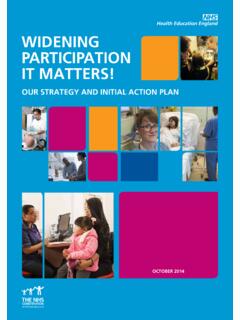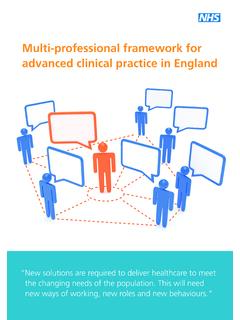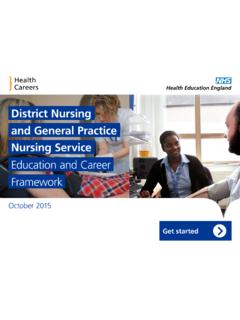Transcription of Facing the Facts, Shaping the Future
1 A draft health and care workforce strategy for England to 2027 For consultationFacing the Facts, Shaping the FutureTo have your say, please see page 133 or visit NHS belongs to the is there to improve our health and wellbeing, supporting us to keep mentally and physically well, to get better when we are ill and, when we cannot fully recover, to stay as well as we can to the end of our lives. It works at the limits of science bringing the highest levels of human knowledge and skill to save lives and improve health . It touches our lives at times of basic human need, when care and compassion are what matter NHS is founded on a common set of principles and values that bind together the communities and people it serves patients and public and the staff who work for Workforce Strategy3 Introduction The NHS is one of our country s finest achievements.
2 As outlined in the NHS Constitution it belongs to, and is a source of pride to, the people. The public health staff in local authorities, those in the voluntary or independent sector providing NHS care and those in hospitals, GP surgeries and our communities as well as colleagues in social care. Social care and health together make up the largest workforce in the country, by comprising 13% of all jobs, yet we have not had a national strategy for recruiting, training and supporting them for over two will change next year. This consultation document will lead to a workforce strategy for the health service to be published in July 2018.
3 This document informs a conversation about what staff need; about what staff the health service needs, and how we shape the Future we all want: a sustainable, free, universal healthcare system. Production of this document was led and co-ordinated by health Education England but it is a product of the whole national system including NHS England, NHS Improvement, Public health England, and the Department of health . In this document we outline why we need a workforce strategy , before detailing the 2017 workforce and how it has changed over the last five years. Workforce growth comes from three main areas: output from education and training, retaining our current workforce, and recruitment of trained workforce from elsewhere.
4 We describe actions to grow capacity and capability to move towards self-sustainability in our workforce and build the NHS s global reputation as a centre of excellence in healthcare education and training. We then extend our lens to 2027, recognising that education and training and workforce reform takes time we look at how new technology, prevention and flexibility are required to meet the service s workforce requirements a decade conclude by discussing the Future for each of our workforce groups, using a focus on professions to analyse need and set out take the time to read this document and respond to the consultation to ensure that the final strategy is a comprehensive product of the whole have your say.
5 Please see page 133 or visit the scene A foreword from Professor Ian Cumming ..5 Chapter 1 Developing a workforce strategy ..11 Chapter 2 Facing the facts The NHS workforce in 2017 ..21 Chapter 3 Growing the workforce ..33 Chapter 4 The workforce response to the Five Year Forward View ..53 Chapter 5 The adult social care 6 Workforce requirements beyond 2021/22 ..73 Chapter 7 Shaping the Future ..79 Chapter 8 Developing the NHS workforce ..95 Improving leadership across the NHS ..96 NHS staff groups ..98 Medicine ..99 Nursing and midwifery ..105 Dentistry.
6 115 Allied health professions ..119 Healthcare science ..123 Pharmacy ..126 The wider workforce ..129 Chapter 9 Conclusion and consultation ..133 Appendices ..136 Draft workforce strategy55 Setting the scene health is all about people. Beyond the glittering surface of modern technology, the core space of every health care system is occupied by the unique encounter between one set of people who need services and another who have been entrusted to deliver them Frenk, J., Chen, L., Bhutta, Z. A., Cohen, J., Crisp, N., Evans, T., Fineberg, H., et al. (2010) Professionals for a new century: transforming education to strengthen health systems in an interdependent world.
7 Lancet 376(9756) pp. 1923-1958 Professor Ian Cumming OBEC hief Executive, health Education EnglandTo have your say, please see page 133 or visit the SceneA national conversationThis is the first time in almost 25 years that the health service in England has set about producing a Workforce strategy . This document is not the final strategy but a draft, designed to present the facts and stimulate debate. It builds on the concepts discussed in health Education England s (HEE) Framework 15, published in 2014. We describe the current state of the NHS, health and care workforce from 2012, outline recent strategic workforce interventions; describe key decisions that will impact on the Future workforce through to 2027; and seek your views on what we should do next to ensure our workforce provides the best quality care to patients, service users, carers, and the public.
8 Your responses will be used to inform the full strategy to be published in July 2018, and then updated annually. HEE has led and co-ordinated this document s production, but it is not an HEE document; it is from the whole national system with content from NHS England, NHS Improvement, Public health England, the Care Quality Commission, NICE and the Department of health . Each have specific responsibilities which impact on the NHS workforce, as set out in as set out on page current workforceThroughout this document we draw on data from the NHS and the health and care system where the latter is available.
9 The NHS spends almost 65% of its operational budget on its most valuable asset; our staff. Almost all clinical professions in the NHS have grown in the last five years. We have over 40,000 more clinicians substantively employed than in 2012, a increase. We have 14,306 more adult general nurses ( ); 445 more emergency medicine consultants ( ); 2,130 more mental health therapists ( ); 2,248 more health visitors ( ); 1,146 more community mental health nurses ( ), and 1,692 more physiotherapists ( ). The ratio of qualified nurses to occupied NHS beds has also increased from to A small number of professions have however seen a fall in employed numbers including 1,674 fewer district nurses ( ), and 842 fewer learning disability nurses ( ).
10 GP numbers have also reduced by approximately 1% since 2012. Overall, the total amount the NHS spent on pay has increased by in real terms from 2012/13 to 2016/17 (substantive and temporary staff). So why doesn t it feel like that? Put simply, because of huge growth in demand and a focus on quality. Since 2012 England s population has grown by million (around 4%), and has continued to age. The number of people with long-term conditions has grown sharply, as have advances in medical care and treatment - keeping more people alive for longer. The drive for safer staffing following the Mid-Staffordshire Trust tragedy saw over 40,000 additional posts for registered nurses created in the NHS.








![Midlands [1 of 2] - hee.nhs.uk](/cache/preview/6/c/1/4/2/e/2/7/thumb-6c142e2790d053a442bd8a3e81c79697.jpg)
